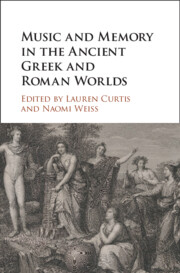Book contents
- Music and Memory in the Ancient Greek and Roman Worlds
- Music and Memory in the Ancient Greek and Roman Worlds
- Copyright page
- Contents
- Figures
- Contributors
- Acknowledgments
- Note on Texts and Abbreviations
- Part I Approaching Music and Memory
- Part II Music, Body, and Textual Archives
- Part III Technologies of Musical Memory
- Part IV Audience, Music, and Repertoire
- Part V Music and Memorialization
- Chapter 10 Sirens on the Edge of the Classical Attic Funerary Monument
- Chapter 11 Music as Mnēma on Athenian White-Ground Lekythoi
- Bibliography
- General Index
- Index Locorum
Chapter 11 - Music as Mnēma on Athenian White-Ground Lekythoi
from Part V - Music and Memorialization
Published online by Cambridge University Press: 14 October 2021
- Music and Memory in the Ancient Greek and Roman Worlds
- Music and Memory in the Ancient Greek and Roman Worlds
- Copyright page
- Contents
- Figures
- Contributors
- Acknowledgments
- Note on Texts and Abbreviations
- Part I Approaching Music and Memory
- Part II Music, Body, and Textual Archives
- Part III Technologies of Musical Memory
- Part IV Audience, Music, and Repertoire
- Part V Music and Memorialization
- Chapter 10 Sirens on the Edge of the Classical Attic Funerary Monument
- Chapter 11 Music as Mnēma on Athenian White-Ground Lekythoi
- Bibliography
- General Index
- Index Locorum
Summary
Through their distinctive iconography and dedicated function as funerary vessels, Athenian white-ground lekythoi of the fifth century BCE serve as significant testimonials about attitudes toward and treatment of the dead. Although the images on lekythoi were not intended as documentary, they nonetheless grant insight into mortuary customs practiced by families and how Athenians conceptualized the deceased and his or her memory. Musical references, while never a predominant subject, can be found on lekythoi throughout their production history. Both living people (male and female) and spirits of the dead (eidōla) hold or play instruments on the vases; instruments can also appear as offerings left at tombs. The multivalence of musical instruments, especially the chelys lyre that is most often depicted, allowed painters to use them to their best symbolic advantage. They can reference a traditional musical education, the archaia paideia, but also evoke virtues like sōphrosynē and commemorative laments performed in honor of the deceased. Recent scholarship on mortuary theory and the deposition of actual instruments in Athenian graves helps support such readings. Whether “real” or pictorial, musical instruments – like the white-ground lekythoi themselves – served as performative objects of memory and mnēmata for the deceased.
- Type
- Chapter
- Information
- Music and Memory in the Ancient Greek and Roman Worlds , pp. 287 - 310Publisher: Cambridge University PressPrint publication year: 2021

